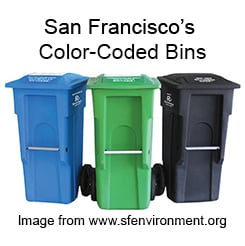 In 2009, the city of San Francisco, California, started a mandatory composting program as part of its waste management plan. All residents and businesses are required to participate. The curbside bins are color coded: blue for recyclables, green for compostables, and black for trash.
In 2009, the city of San Francisco, California, started a mandatory composting program as part of its waste management plan. All residents and businesses are required to participate. The curbside bins are color coded: blue for recyclables, green for compostables, and black for trash.
When the city passed this ordinance, they wanted to address the 35% of trash that was compostable. This organic matter does not break down safely in a landfill. The other items in the landfill bury the organic matter in layers. This is an anaerobic environment, lacking oxygen. Dangerous and malodorous bacteria multiply, creating a stinky mess. Much of the organic matter only partially breaks down. It is forever entombed in the landfill.
When food scraps are put into the right conditions, they can easily break down. The resulting finished compost is beneficial to the environment in several ways:
- Finished compost can be used as a fertilizer to nourish living plants.
- Organic fertilizer does not contain chemical fertilizers.
- Most chemical fertilizers are made from petroleum, which is not renewable. Organic fertilizer is renewable.
- Instead of being permanently stored in a landfill, the organic waste continues to be part of the natural cycle of life.
- The amount of materials added to the landfills decreases, while the city gets fertilizer.
How the Composting Program Works
Recology is handling most of the collection of organic materials. City residents place kitchen scraps into large green bins. On pickup day, home owners place the bins at the curb. The odor is no worse than regular mixed trash. Recology picks up the bins and empties them into trucks.
Composting facilities, such as Jepson Prairie Organics, receive the organic waste and start breaking it down. Jepson processes 100,000 tons of organic material per year from this program. Food waste is mixed with yard matter and ground up. This process creates a mixture of green and brown material that is ideal for composting.
The material is placed in the Engineered Composting System for 30 to 45 days. During this time, the material breaks down. The company monitors moisture and oxygen levels. The material is turned and moistened with water. When this process is complete, the material is screened to filter out large pieces, then placed on windrows to cure. After curing, they screen the compost one more time. Finally, the finished compost is available for sale.
Large-scale composting programs like these have the chemistry of composting down to a science. They could use aerobic or anaerobic bacteria in a controlled environment to break down the waste. In this example, Jepson seems to be using aerobic composting. They are adding oxygen when they turn it.
Composting programs large and small often use composting worms to break down the compost faster. Red worms are especially popular because they are hearty and hungry. Worms carry valuable soil bacteria that enhances the quality of the finished compost. It’s not clear how much worms are used in this particular program. However, many composting programs elect to harness the power of the humble worm.
The composting program is required, and tenants can anonymously report landlords who do not provide bins. However, the city estimates that more half of compostable and recyclable materials are still getting mixed in with trash. The city has banned plastic bags and is working toward zero waste by 2020.
Source: sfenvironment.org
Note: If your municipality or city does not have curbside composting, you can start your own composting program at home! Just order a composter and red worms from Uncle Jim’s Worm Farm. We have lots of instructions on our website. Find out how to set up and maintain a successful organic waste management program right at home. No matter whether you live in an apartment or on 100+ acres of land, you can help save the environment and get free fertilizer.








